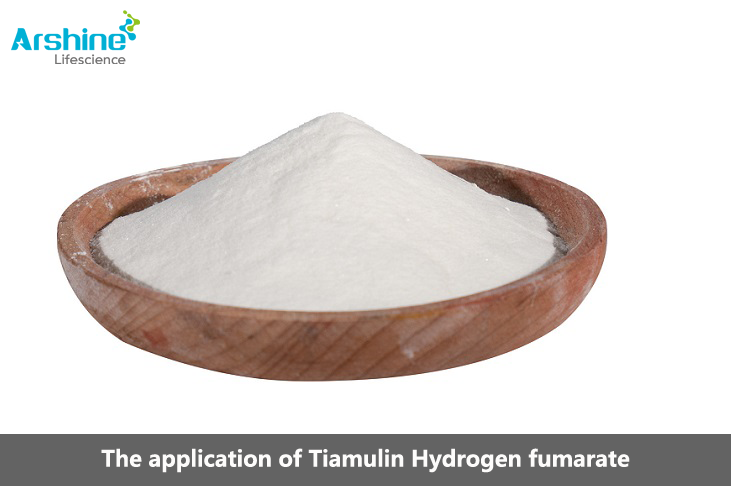

Tiamulin Fumarate is the fumaric acid salt of tiamulin, appearing as a white or off-white crystalline powder with no odor or taste. It is used to treat pneumonia in pigs caused by Actinobacillus pleuropneumoniae and swine dysentery caused by Brachyspira hyodysenteriae. As a feed additive for pigs, it promotes weight gain. It is also effective against chronic respiratory disease in chickens, mycoplasmal pneumonia in pigs, pleuropneumonia caused by Haemophilus parasuis, and staphylococcal arthritis in chickens.
Tiamulin Fumarate is a bacteriostatic antibiotic with bactericidal activity at high concentrations against susceptible organisms. Its antibacterial mechanism involves binding to the 50S ribosomal subunit of bacteria, inhibiting bacterial protein synthesis. It exhibits good antibacterial activity against various Gram-positive cocci, including most staphylococci and streptococci (except for group D streptococci), as well as against certain mycoplasmas and some spirochetes. However, its activity against some Gram-negative bacteria is weak, with the exception of certain strains of Brachyspira hyodysenteriae and some Escherichia coli and Klebsiella strains.
Difference between Tiamulin and Tylosin
Tiamulin and tylosin are entirely different products. Tiamulin is not a macrolide antibiotic but a pleuromutilin, inhibiting the growth and reproduction of mycoplasma. Tylosin, on the other hand, can kill mycoplasma, with the minimum inhibitory concentration against mycoplasma being one-tenth of that of tiamulin. Tylosin also enhances nonspecific immunity, inhibits the replication of porcine circovirus type 2 in macrophages, and promotes growth, making it a more versatile antibiotic suitable for large-scale pig farms. Tiamulin's primary functions include direct killing of mycoplasma, inhibition of porcine circovirus type 2 replication, enhancement of nonspecific immunity, growth promotion, and specific treatment for proliferative enteritis (ileitis) and swine dysentery.
Routine Use of Tiamulin Fumarate
Prevention and Treatment of Swine Mycoplasmal Pneumonia Use tiamulin fumarate in combination with sulfonamide drugs (added at 20 mg/kg body weight) for 7-10 days to treat coughing pigs infected with mycoplasma. For prevention, it is recommended to administer the medication 14 days before farrowing in sows and 14 days before the high-risk age:
a. In the 14 days before farrowing, add tiamulin fumarate at 150 mg/kg body weight and colistin sulfate at 40 mg/kg body weight to the feed. This not only reduces the mycoplasma content in sows but also reduces the levels of pathogens such as Escherichia coli and Salmonella in sows, preventing piglets from being infected with mycoplasma and swine dysentery after birth.
b. 14 days before the high-risk age, as the high-risk age for mycoplasma pneumonia in fattening pigs is 100-120 days, it is recommended to start adding tiamulin fumarate at 100 mg/kg body weight and tylosin at 300 mg/kg body weight to the feed from day 95, continuously for 7-14 days, to reduce the mycoplasma content in the pig population and prevent mycoplasma pneumonia.
Prevention and Treatment of Swine Respiratory Disease Complex There are two high-risk periods for swine respiratory diseases: after weaning and after nursery pigs are transferred to fattening pigs:
a. After weaning, add tiamulin fumarate at 150 mg/kg body weight and doxycycline at 200 mg/kg body weight to the feed from 7 days before weaning to 7 days after weaning, for a total of 14 days. At this time, in addition to preventing respiratory diseases, it also prevents post-weaning stress diarrhea in piglets.
b. For nursery to fattening pigs, add tiamulin fumarate at 150 mg/kg body weight and doxycycline at 200 mg/kg body weight to the feed 7 days before the transfer and continue for 7 days after the transfer, for a total of 14 days.
Prevention and Treatment of Swine Proliferative Enteritis If there has been a history of proliferative enteritis in the pig farm, tiamulin or tylosin can be added to the feed one month before the high-risk age. Generally, add it at a dose of 35 mg/kg body weight, continuously for 7 days, then repeat the process after a 14-day interval, to effectively prevent the occurrence of proliferative enteritis. For treatment, it is recommended to add it at a dose of 40 mg/kg body weight and continue for 21 days to thoroughly eliminate bacteria and prevent recurrence.
Precautions
This product should not be used concurrently with polyether antibiotics, as it can cause drug poisoning, resulting in slow growth, motor disorders, paralysis, and death in chickens. Although pigs react less severely, concurrent use should also be avoided.
This product is relatively safe for oral administration to chickens and pigs. It can tolerate 3-5 times the oral dose. However, occasional reactions such as skin redness may occur. Overdosing in pigs can cause transient salivation, vomiting, and central nervous system depression. Discontinue the medication and provide symptomatic treatment.
Withdrawal period: 5 days for oral administration to pigs.
This product is irritating, so avoid contact with the skin or mucous membranes.
When the room temperature exceeds 40°C, the feed containing tiamulin should not be stored for more than one week.
Pay attention to the contraindications of tiamulin, especially its incompatibility with antibiotics such as virginiamycin and monensin.
Add: Block 14, No.100, Luyun Road, Changsha 410205, Hunan, China.
Email: info@arshinevet.com
WeChat: +8618874001228
WhatsApp: +8615697311407
Tel:86-731-82294958